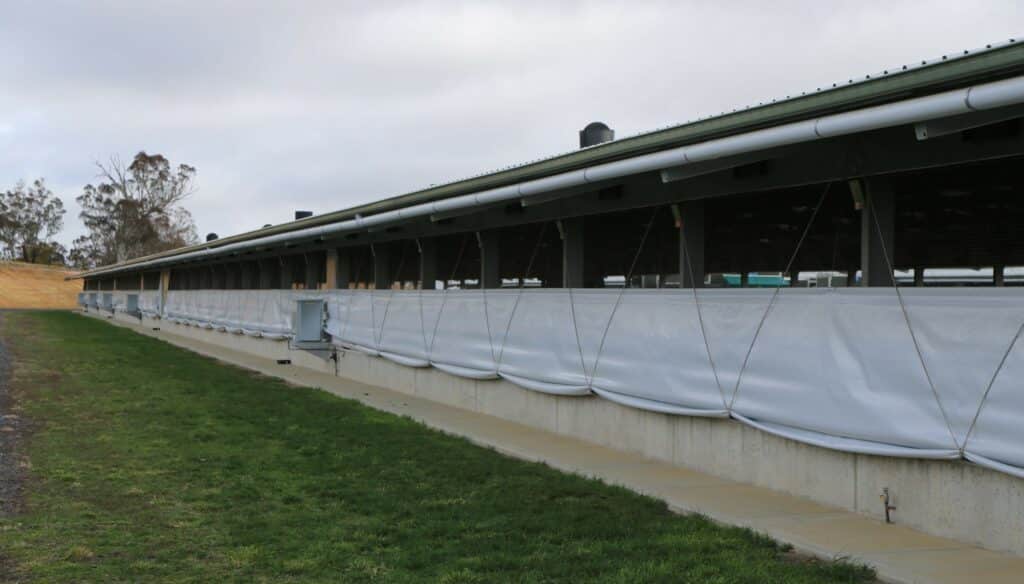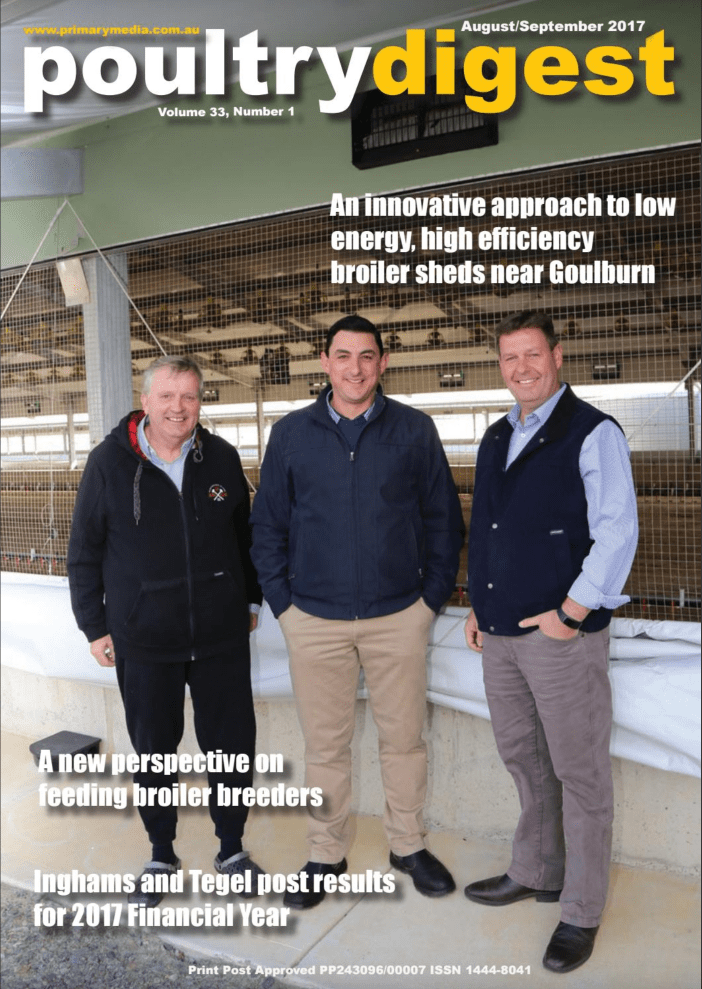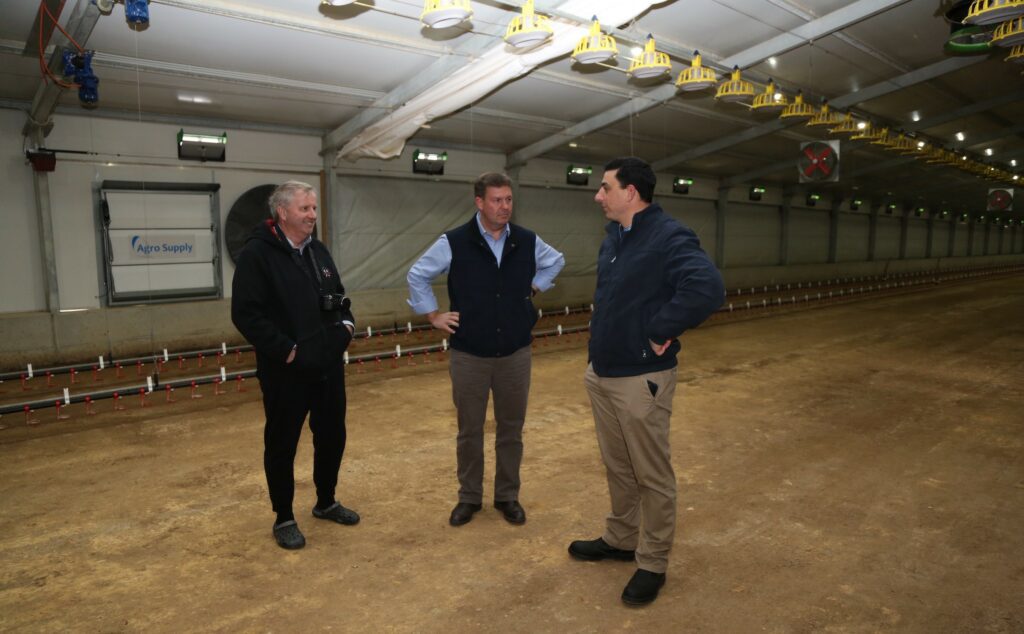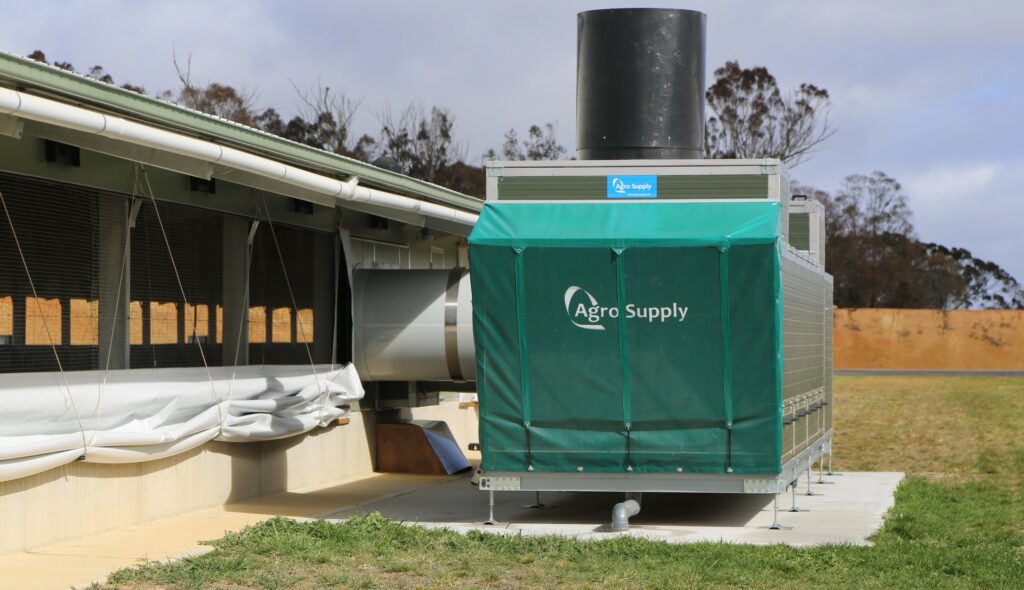
Eddie Wehbe, a builder and now the owner of these sheds, was in his own words, “getting a bit bored with residential construction” and seeking new challenges. He decided that he wanted to build his own broiler farm.
With a fabulous site for his enterprise already acquired, he approached Patarker, the long-established two-generation poultry shed equipment supplier run by Gerry, Paul, and Michael Bigeni, from Jamisontown in NSW.
Paul Bigeni takes up the story. “Eddie was incredibly enthusiastic and wanted to try a rather different approach to climate-controlled broiler sheds that suited the particular climate and location of his farm,” he said.
As Poultry Digest approached Eddie’s farm, the first impressions were of a secure property down a long private road that with fencing and surveillance equipment, made for a very secure broiler farming enterprise. Eddie opened up the gates and started to explain how his ideas had become a reality.
“This site has a climate more typical of Northern Europe than the prevailing warm and humid conditions of much of Australia’s coastal regions,” he said.
“I fully understand why broiler farmers would build fully enclosed tunnel sheds in our warmer areas, but for my farm, I wanted to look at the cool zone European approach.
“I based my design philosophy on an abundant supply of cool fresh air and the ability to make the most of this feature for my farm,” he said.

Windmills churning away on the crest of ridges some kilometers behind the farm, certainly bore out Eddie’s statements about prevailing conditions, as did the 5 degrees C at 9.00 a.m!
“I liked the idea of being able to open up the sheds but still needed a thermally efficient answer to keeping the sheds at the optimum temperatures for the rearing cycles,” Eddie said.
Patarker helped us with ideas to achieve the design that suited both our climate and the requirements of our livestock. “The company then introduced us to Polytex and its ability to use modern materials to fabricate thermally efficient and easy-to-manage shed curtains,” Eddie said. Paul, Eddie, and Rod initiated discussions for the design of the thermal curtains and Rod was able to recommend a triple-layered fabric option. The curtains comprised of an inner and outer layer of Polyethylene fabric with a 15mm air-cell inner. The curtains had to meet three important benchmarks for them to be successful, firstly providing thermal efficiency, secondly, the ability to be raised and lowered using modern and electronic winching systems, and thirdly, a complete light block-out. The successful curtain design was proven as Eddie commented onsite “they are almost as thermally efficient as the 50 mm thick conventional foam shed wall material.
“We used an electronic infrared thermometer and noted a two-degree variation between the thermal curtains and the 50mm foam wall, and of course being fully flexible they can be adjusted i.e. raised and or lowered to suit the climatic conditions and bird requirement, unlike a fixed combination foam wall construction.
The curtains are manipulated through electric winches and connected to a state-of-the-art F38 Fancom controller. They are an integrated component of an overall climate control system that includes Fancom mini vents, Patarker stirrer fans, and Fancom’s market-leading ‘smart’ chimney fans.
At this point in the story, it is probably best to emphasise that Eddie’s sheds are not a retro ‘back to the past’ rehash of shed design from 50 years ago when the broiler industry started to go down the intensive track to satisfy growing consumer demands.
No, they are a combination of the best available technologies to manage the shed climate in a very particular location. “I like rammed earth shed floors,” Eddie stated firmly. “They don’t sweat, are cost-effective and absorb moisture and as with our other design features, they suit our climate”.

We proceeded to a tour of the farm and Eddie demonstrated key features of the shed design as we raised and lowered the Polytex curtains.
Rod Martin and Managing Director of Polytex, David Horsfall joined us and pointed out critical details like the sealing strip where the curtains are fixed to the shed walls.
“If these curtain-sided sheds are going to perform like fully enclosed tunnel housing, the efficient seal is vital,” Eddie said. After two years of continual use, the curtains still look as new and Eddie confirms they have truly met expectations. Other features of the shed design that Eddie pointed out were the extended eaves, just short of 2m, gutter to the wall.
“It keeps a large area of the shed sides cool in summer and protects the shed from rain, and yes, around here, snow,” Eddie explained. “Snow and ice don’t stick to the curtains but quickly bond to other materials including steel and even smooth solid walls, conditions that don’t help when the shed needs to be warm enough for the birds, particularly in the brooding phase.
Inside the sheds, we see how the shed would operate in fully sealed mode with the combination of minimum vents, stirrer fans, and smart chimney fans, along with the curtains all operated through a Fancom control system. However, there is another critical innovation that delivers a whole raft of benefits to the shed operation and bird well-being and that is the Agro Clima 200 heat exchanger units, one for each shed.
Poultry Digest spoke to Paul Bigeni the day after visiting Eddie’s sheds. Paul, like Eddie, and now Poultry Digest are truly impressed by the potential for better shed control offered by modern heat exchanger technology. ”The heat exchangers at Eddie’s farm supplied by Patarker are from Agro Supply, a unit of the Vencomatic Group. “The Clima unit 200 heat exchanger ended up as being one of the most exciting parts of the project, especially for us as it gave us the chance to prove this advanced European technology,” Paul said. “Initially we were looking purely at gas savings and litter control but were even more excited when we discovered that other benefits for broiler farmers were of huge significance.
“Agro supply calls them Clima units for a good reason and that is they can actually take over the whole climate of the shed, especially when the birds are young. “The main function of the units is humidity control and dust removal. If you are able to control humidity perfectly and capture internal dust and ammonia, a whole range of other benefits come into play.
“These benefits, such as a clean environment for birds and staff, lower emissions, better litter control, uniformity of birds, reduced building and equipment corrosion, as well as a faster cleaning process at the end of flocks.
“We see Clima units as potentially a new way of achieving efficient minimum ventilation into the future,” Paul concluded.

Patarker supplied and designed all the internal equipment, electrical, and plumbing on the farm, completed the installation, commissioning, and training of Fancom controllers and associated ventilation equipment. Other items supplied include Super Saver Heaters, Roxell feeders, Ziggity drinkers, Patarker stirrer fans, foggers, and all equipment winches and Polytex thermal curtains.
Other important aspects of the farm design are that water is captured from the shed roofs but only used as ‘grey water’ for washdown purposes around the property.
All drinking water for the birds is obtained from bores, filtered, and treated before distribution to the drinker lines.
“Given that heavy rain is not unknown in our part of the world we have installed hard surfaces around sheds and driveways to ensure effective drainage,” Eddie pointed out.
A further interesting aspect of Eddie Wehbe’s farm is that he is an independent supplier of grown birds.
“This means that we can grow to the requirements of any of the integrators, including RSPCA protocols.
“We know that bird quality is critical and that is why we have invested considerably to ensure we consistently maintain the best environment for bird health and optimal growth patterns,” Eddie stated.
Eddie Wehbe’s dream of creating a state-of-the-art broiler farm that works with his climate rather than against it, may become a signal for future growers to consider as energy bills rise but demands for more efficient and consistent broiler rearing increases.
The innovative technology on this farm was firstly the result of an imaginative farmer who saw the potential for better poultry rearing, then by seeking advice and following it, from a family company with decades of combined experience in the poultry industry.
The end result is a combination of original thought, simple but effective components like more efficient shed curtains adapted to 21st-century automation, and the simply amazing technology of heat exchangers.
Driving away from Eddie’s farm back to Sydney, Poultry Digest reflected on the fact that we had just seen firsthand what could be a steep change in broiler shed technology.
And that is not the first time we have experienced this.
Almost 17 years to the day, just weeks after acquiring Poultry Digest in 2000, we met a very young Paul Bigeni at a new tunnel-ventilated shed at Marsden Park.
Just before Sydney entered a month of Olympic frenzy we had to obtain a grower story for our September/October 2000 issue. It was our first experience reporting on a state-of-the-art tunnel shed.
The day had started at around 5 degrees C at sun up but despite the fact that it was early September, by 11.00 a.m it was over 30 and still climbing. The new Fancom shed controller was struggling to compute the huge sudden temperature range but Paul went to work like a ten-year-old with a new iPhone.
In a short space of time, computers, main fans and evaporative coolers were all singing from the same hymn sheet and the very young birds settled after a scary start to the day.
That shed was one of many commissioned in the period to serve the rapidly increasing demand for ever-cheaper chicken.
Energy in Australia was the second cheapest on the planet, free range meant somebody had left a shed door open and supermarkets, integrators, and contract growers, were all getting on like a house on fire. That was then.
Seventeen years on, the broiler industry faces a very different landscape, but as tunnel ventilation, automation, and cheap energy served the needs of growers in 2000, energy efficiency, more intelligent design, and ever more innovative technology will, if applied properly, see the industry through in current circumstances.
Written by Peter Bedwell
– Poultry Digest, Volume 33, Number 1